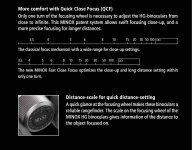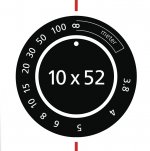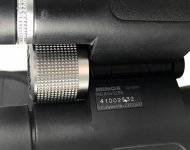I still kind of feel like some of these responses , though well thought out, are not addressing my question so I will simply reiterate: ...... I'm talking primarily innovative technological changes that would allow exceptionally wide fields of view, variable zoom, image stabilization (which could allow even more magnification), variable speed focuses, better control of glare and stray light......
Two items on the list (variable speed focusers or effective control of glare and stray light) don't need any innovative technology.
I've seen the patent drawings for the Kamakura variable speed focuser that was used in the Brunton Epochs (and also presumably in the Nikon Monarch Fieldscope, new Vortex Razor, Zeiss Gavia and other scopes). It could hardly be cheaper or lower tech: essentially a slot in a rotating collar is made curved rather than straight.
No innovative technology is needed to control glare either. It's just a matter of placing the right sized baffles in the right places, also cheap and low tech. Why it isn't always done properly is a mystery to me.
I think you've well and truly got all your answers by now, and anything further will just end up in 'paralysis'

As has been said, any changes are likely to be incremental, and within your Mark 1 eyeball's margin of error (or deterioration anyway

:cat:
Look at your initial questions from a manufacturer business point of view over the next decade ....
* Exceptionally wide fields of view = not happening (way expensive and heavy)
If we get improvements over the Zeiss SF - ie. ~ 70° AFov's that are well controlled and corrected, we will be lucky ....
* CA improvements = incrementally possible (at an expense)
Already the market leaders are pretty well controlled on axis. In the whole optical train design minor improvements may be possible with including such things as appropriately finished aspherical elements and premium materials - but will you actually notice any practical difference except on your wallet ?! :cat:
* Variable Speed Focusers = doable.
Swarovski's SV, and Zeiss's SF would be prime candidates
* Better control of glare and stray light = doable.
Manufacturer's are constantly updating coatings etc to make tiny incremental improvements anyway .....
* Advanced materials = maybe ....?
It's not a big step to turn GRP (glass reinforced plastic) into CFRP (carbon fibre reinforced plastic). The biggest hurdles would seem to be around all the HunTers marketing dross of Magnesium and 'toughness' ..... and the investments in supply chain and technology. More a matter of vision and will than anything else, and could be used to offset the weight of wider field optics. Carbon 'Diets' would be useful for the Leica NV, Swarovski SLC, and any Zeiss HT successor .....
* Ergonomically friendly Image Stabilization = not happening anytime soon (complete integral redesigns needed and that won't be cheap!

* Actually usable Zoom = not happening anytime soon (technical complexity again equals expense. 'DuoVids' are feasible and it would be interesting to see an updated extra wide field, lightweight design - perhaps even with IS, but it would be a brave manufacturer investing so much for such a limited market. It will be cheaper and more feasible to implement the digital solution ..... eventually

.
Don't worry - Be Happy !
Any preferences you have for a current (or near superceded) format, view, handling, fit to yer noggin, and ease of view, likely outweigh any minor incremental improvements on the near-mid term horizon, especially as this industry moves rather s-l-o-w-l-y .....
The only thing guaranteed to be "obsolete" is ........... Time :eek!:
Chosun :gh:










